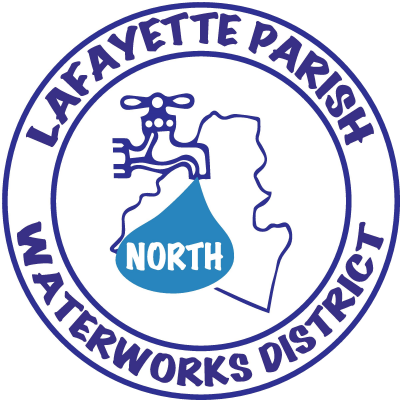Every day we rely on water, it is our lifeline. It keeps our lives healthy and sanitary. When we use water from our faucets, we assume and expect it will be free from contamination. Lafayette Parish Waterworks District North’s Cross-Connection Control and Backflow Prevention Program is designed to prevent contaminated water or other unapproved substances from entering the public water system.
What is Backflow?
The American Water Works Association (AWWA) defines backflow as the undesirable reversal of flow of fluids, gases or other substances into a potable water distribution piping system as a result of a cross-connection.
What is a Cross-Connection?
Cross-Connections are defined as actual or potential connection between a potable water supply and a non-potable source. The connection could allow contaminates or pollutants to enter the drinking water supply. Lafayette Parish Waterworks District North has enacted a resolution requiring the elimination, or the installation of approved backflow prevention assemblies for the contro,l of cross-connections.
Required Annual Testing of Backflow Prevention Assemblies
While backflow prevention assemblies do a good job at protecting the water supply, they must be tested and maintained regularly to make sure they are in proper working order. Since they are mechanical they have springs, seats, rubber seals and moving parts that wear out overtime. Lafayette Utilities System requires backflow prevention assemblies to be tested on an annual basis.
Tester Information
There are two types of testers: General Testers and Water Supply Protection Specialist (WSPS) Testers. General testers are only allowed to test backflow prevention assemblies. General testers cannot install or perform maintenance on backflow assemblies. WSPS testers are licensed journeyman or master plumbers, and Horticulture Commission of Louisiana- licensed landscape irrigation contractors (irrigation contractors are only to test, install and maintain backflow assemblies on landscape irrigation systems.) WSPS plumbers can test, install and maintain any backflow prevention assembly.
Due to the fact that test prices vary among testers, you may want to contact several certified testers to obtain quotes for your test. If you have questions regarding the Cross-Connection Control and Backflow Prevention Program, please contact the LPWDN at 337-896-8683 or by email at customerservice@lpwdn.com.
Lawn Sprinkler System
These systems pose particular hazards whether they are at residential or commercial locations. The sprinkler heads, while usually acting as exit points for the distribution of water to the lawn, can act as entrances for contamination as well. Because the heads are at ground level, they are subject to applications of fertilizers and pesticides, and infiltration by parasites and bacteria. Without any type of protection, a backflow event could easily draw contaminates in through the sprinkler heads, through the irrigation piping system, and into the potable water distribution system.
• A pressure vacuum breaker may be used for irrigation systems with no injector pumps.
• A reduced pressure assembly is required for irrigation systems with injector pumps.
BACKFLOW PROTECTION IS REQUIRED ON ALL IRRIGATION SYSTEMS
Depending on the type of irrigation system: Air Gaps, Vacuum Breakers (Pressure, hose or atmospheric depending on the application), or Reduced Pressure Assemblies are required to isolate the irrigation system from the potable water system.
A plumbing permit is required to install lawn irrigation sprinkler systems anywhere in Lafayette Parish. Contact Lafayette Consolidated Codes Division at (337) 291-8461 to obtain permits.
Residential Requirements
Private Wells
Backflow can also occur in the absence of a water main pressure drop. For example, some homes have backup water systems supplied by private wells. If these systems are interconnected the well pump may overcome the pressure in the public water supply, thus backpressure backflow will occur. Because these private supplies are not tested and regulated by governmental agencies, they may pose a hazard to the potable water system and must be equipped with proper backflow protection.
Outside Faucets or Hose Bibs
Hose bib vacuum breakers consists of a spring-loaded check valve that seals against an atmospheric outlet when the water supply is turned on. When the supply is turned off, the device vents to atmosphere, thus protecting against backsiphonage conditions.
A diagram of a hose bib vacuum breaker is illustrated below along with a typical installation:
Garden Hoses are an extension of your homes water supply. Water users commonly use garden hoses for a variety of purposes including:
- Watering lawns, flower beds and gardens
- Washing cars, houses, pets and other items
- Filling pools, hot tubs, ornamental fountains and fish ponds
- Applying liquid fertilizers, pesticides and herbicides
- Filling livestock water troughs with garden hose or with automatic fillers attached to the trough
Any of these may involve attaching a chemical reservoir to the end of a hose. In each of these cases, there is a potential to contaminate the water supply. Hose Bib Vacuum Breakers are simple, low cost devices that should be used to prevent backflow of water when engaging in the use of water hoses. Homeowners can easily install HBVB’s and they are available at many plumbing supply stores.
Commercial-Industrial Requirements
In commercial or industrial situations, water often comes in contact with different types of hazardous substances, whether it is for mixing, diluting, flushing or cleaning. State law requires that certain businesses be surveyed for potential cross-connections and that proper backflow prevention assemblies are installed to protect the public water supply.
If your business requires a survey, we will contact you for an appointment and meet with you at your facility to identify specific hazards and discuss the applicable backflow prevention requirements.
• An AIR GAP is required at facilities that handle sewage or radiological materials
• A REDUCED PRESSURE ASSEMBLY is required for High Hazard locations
• A DOUBLE CHECK VALVE ASSEMBLY is required for Low Hazard locations


 Cross Connection Questionnaire
Cross Connection Questionnaire